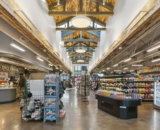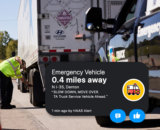Whether it is a professional driver looking to grab a sandwich and a Mountain Dew, an owner operator shopping for clothing or the four-wheel traveler heading to the restroom, most customers can be identified as either shoppers or buyers.
“Someone who is a shopper is someone who comes into your store, takes time, walks down the aisles and is looking to get something at your store. A buyer is someone who comes in and grabs something and leaves,” said Darren Schulte, vice president of membership. “If you have shoppers, they’re often looking for deals. If you have buyers, they are coming in and grabbing.”
Understanding the difference between shoppers and buyers can help operators tailor promotions to boost sales. Schulte said, “Does it make sense to promote your soda deals on days when customers are coming in and buying without shopping? Does it make sense to offer a deal on hot dogs during lunch when people are coming in and grabbing hot dogs or does it make sense to offer those deals in non-traditional hours when people are coming in and not heading straight to buy?”
The number of shoppers vs. buyers in a store can vary by the time of day or the day of the week. Most of the customers are after convenience. “There is a belief that drivers are in there for a long, long time, but they’re not, at least not during the day,” Schulte said. “More and more of the restaurants are declining in our industry and that tells you people are not spending time in our stores. The grab and go is growing and that is all about being quick.”
John McMahan, national retail sales—convenience retail director with Coca-Cola, said that he has learned that male convenience store customers spend between two to three minutes in a store, whereas the female convenience store shopper spends more time in the store and captures more four- to five-minute trips than male shoppers.
“Females often will shop. They will spend time walking through a store and shopping,” Schulte said. “A male shopper is very different. I use myself as an example. When I shop for my wife, I see something on a mannequin and say, ‘I want that.’”
Younger shoppers spend less time in the store than older shoppers, McMahan said. Those with white-collar jobs spend less time in a store than those with blue-collar jobs and those from higher income households spend less time in a store when compared to those with lower income households.
McMahan said white shoppers spend the least amount of time in a store while Hispanic shoppers spend the most amount of time in a store.
Locations can find clues to who is shopping by looking at their busiest days and their sales data. “Their busiest diesel days may be Monday, Tuesday and Wednesday, but their biggest shopping day might be Friday, Saturday and Sunday. As consumers, we’ve been taught to shop on the weekends, and if that is when owner operators are coming in, there will be more shopping taking place,” Schulte said, adding that owner operators tend to spend more time shopping for apparel, truck accessories and electronics than company drivers.
Operators can also look at their basket item analysis to get a view of the customer’s shopping cart. “What are people actually buying when they’re in your store? If you have a high amount of sales in apparel, that would lead me to believe you have a lot of owner-operators in your store. When customers buy milk, do they buy a quart of oil with it? That will tell you that you have a local customer. If they’re purchasing the milk because it is a good price and they need oil for an older car, you might have a lower income demographic,” Schulte said.
Buyers sometimes turn into shoppers if they find their must-have item quickly, McMahan said. “From research we have seen, the quicker the [shoppers] find their desired item, the more likely they are to stay in the store longer and shop for other items,” he said.
To make it easy for a shopper to buy an item, McMahan suggests operators provide items that are a good value and in a convenient location and maintain in-stock levels. They can also tap into different package types for various shopper needs and different package sizes for various occasions, he said.
Locations’ offerings can help determine whether their customers are shoppers or buyers. “Product choice can change your customer from a shopper to a buyer as can the way your store is laid out. Gifts are shopped. Apparel is shopped. Electronics are shopped. But if you want a cookie, you go in and grab a cookie,” Schulte said. “If you are seen as a destination—maybe you’re the only one that sells Cinnabon or Starbucks in 100 miles or you sell certain blankets that are very popular—that can influence whether people are buyers or shoppers.”
A location’s layout and design can help spur purchases among those customers who come in to look around. “You can to make things pretty or design to sell things,” said Michael Lawshe, chief executive officer with Paragon Solutions. Lawshe said the author of the book Why We Buy, Paco Underhill, talks about the transition zone between the outside and the inside. He explained that anything retailers place in the first eight feet of that transition zone can be lost on shoppers because they simply don’t notice it. “At truckstops, how do you put truckers in the buying mood when they walk in? You have to be more creative to make that work, but it is all about creating a buying experience,” he explained. Within the c-store, people want to see something different, Lawshe said. “They want to be impulsed. They want you to show them the latest and greatest,” he said. “To create a buying experience, you have to get their attention. Be creative and different and shake it up.”
Deanne Schatz-Eisenschenk, manager at the Petro in Fargo, North Dakota, said, “I think that you have to have something in your store that the shopper wouldn’t expect to see here, then they will buy. I don’t want my customer to see the same gadgets and gimmics in my store that they see in a store 180 miles down the road,” she said.
Lawshe said truckstop operators can look to other retailers, such as Old Navy, for inspiration. “Old Navy is constantly changing the table at the front of the store because they want the greeting to be about what is fresh and new. In our industry we can get stagnant or vendor controlled,” he said.
Some retailers use moveable displays that they move in and out. “What if you had a hot case on wheels where in the morning you had breakfast sandwiches or soft pretzels. Not a big display, just a small display that people walk in and see something different,” Lawshe said.
Recently, Lawshe visited an operator that had 10 vendor-supplied displays across the front counter. “They were free, but you need to design your front counter with a purpose to bring something up to the buying zone, which is just under eye level,” Lawshe said.
“If something is on your cashier counter for more than a few weeks, it is old and stale looking. You have to shake it up and make it interesting to get customers’ attention,” Lawshe said.
To cut down on clutter, Schatz-Eisenschenk asks her staff to watch their inventory and only keep what is selling. “It’s easy to just pack your store full of clutter,” she said, adding that clutter can keep customers from seeing the good things a location offers.
Clutter also makes customers feel like “things are old and stale,” which can make them wonder if the food is fresh or if a bag of chips is outdated, Schatz-Eisenschenk said.
Lawshe said to capture sales, operators need to be creative. “Be interesting. Be innovative. Be different with a purpose,” he said.
Six Tips For Turning Shoppers Into Buyers
1. Create and emphasize your unique selling proposition.
Every location should have something that makes it different. “Maybe you offer the lowest price on fuel or the biggest selection of truck accessories. Whatever it is, figure out what makes you different from the competition and share what it is that sets you apart,” said Darren Schulte, vice president of membership for NATSO.
2. Offer unique items.
“Unique items that aren’t pocketbook breakers are an easy way to turn the shopper into a buyer, and when they come back they will look for the unique item they wouldn’t expect to see,” Deanne Schatz-Eisenschenk, manager at the Petro in Fargo, North Dakota, said.
3. Create unique displays.
Micahel Lawshe, chief executive officer of Paragon Solutions, warns operators to be wary of using the same displays and end caps that are controlled by the vendor. “How is that giving you a distinct welcoming experience for the customer? What if we created something that was more welcoming, more unique and more you? Say, ‘This is my signature opening. This is how I’m welcoming the customer in.’”
4. Adjust your sales pitch to the customer.
Certain customers might respond better to certain things. Train your cashiers to talk with customers and offer suggestions on what to say. “At some of our locations, if we are doing a two for $2 special, one property might be hugely successful with the program by saying, ‘Do you want to buy a snickers bar for $1’ instead of, ‘Hey do you want to buy a Snickers bar? They are 2 for $2.’ It varies by the customer level. I think our associates do a fairly good job of deciding what techniques work best,” said Herb Hargraves, director of sales at Cash Magic. (JUMP to page 20 to understand more about the truckstop and travel plaza customer).
5. Create a positive retail experience.
“You can break it down into every part of the store. When you go into a restroom and it is dirty, it isn’t a retail experience that says, ‘Gee, I want to go and eat now.’ I know it seems obvious, but it is important to think about,” Lawshe said.
6. Focus on the ‘buying zone.’
Lawshe said, “Create a way to present your product, whatever that product is, that is attractive and in that buying zone so when a customer walks up to the counter, instead of seeing a side of a register, cords, paperwork, pens, the Coke the clerk is drinking, they see whatever seasonal or high-impulse product you want them to see. You create a buying zone.”
Subscribe to Updates
NATSO provides a breadth of information created to strengthen travel plazas’ ability to meet the needs of the travelling public in an age of disruption. This includes knowledge filled blog posts, articles and publications. If you would like to receive a digest of blog post and articles directly in your inbox, please provide your name, email and the frequency of the updates you want to receive the email digest.

